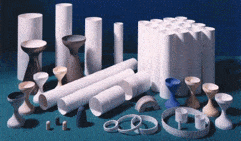CPIM is pleased to provide high-quality Chinese technical ceramics services.
Ceramics for today’s engineering applications can be considered to be non-traditional. Traditional ceramics are the older and more generally known types, such as: porcelain, brick, earthenware, etc. The new and emerging family of ceramics are referred to as advanced, new or fine, and utilize highly refined materials and new forming techniques. These “new” or “advanced” ceramics, when used as engineering materials, possess several properties which can be viewed as superior to metal-based systems. These properties include high resistance to abrasion, excellent hot strength, chemical inertness, high machining speeds (as tools) and dimensional stability.
Classifications of Technical Ceramics
Technical Ceramics can be classified into three distinct material categories:
Each of these classes exhibits unique material properties.
Oxide Ceramics – Oxidation resistant, chemically inert, electrically insulating, generally low thermal conductivity, slightly complex manufacturing and low cost for alumina, more complex manufacturing and higher cost for zirconia.
Non-Oxide Ceramics – Low oxidation resistance, extreme hardness, chemically inert, high thermal conductivity, and electrically conducting, difficult energy dependent manufacturing and high cost.
Ceramic-Based Composites – Toughness, low and high oxidation resistance (type related), variable thermal and electrical conductivity, complex manufacturing processes, high cost.
Ceramic materials are usually ionic or covalently-bonded materials, and can be crystalline or amorphous. Non-crystalline ceramics, being glasses, tend to be formed from melts. The glass is shaped when either fully molten, by casting, or when in a state of toffee-like viscosity, by methods such as blowing to a mould. If later heat-treatments cause this class to become partly crystalline, the resulting material is known as a glass-ceramic.
Ceramic production is a very demanding and complex procedure. High purity materials and precise methods of production must be employed to ensure that the desired properties of these advanced materials are achieved in the final product. One of the final stages in the production of advanced materials is finishing to precise tolerances. These materials can be extremely hard, with hardnesses approaching diamond, and thus finishing can be quite an expensive and slow process. Finishing techniques can include laser, water jet and diamond cutting, diamond grinding and drilling; if the ceramic is electrically conductive, techniques such as EDM (electrical discharge machining) can also be used.
Crystalline ceramic materials are not amenable to a great range of processing. Methods for dealing with them tend to fall into one of two categories – either make the ceramic in the desired shape, by reaction in situ, or by forming powders into the desired shape, and then sintering to form a solid body. A few methods use a hybrid between the two approaches.
The principles of sintering-based methods is simple. Once a roughly held together object (called a “green body”) is made, it is baked in a kiln, where diffusion processes cause the green body to shrink. The pores in the object close up, resulting in a denser, stronger product. The firing is done at a temperature below the melting point of the ceramic. There is virtually always some porosity left, but the real advantage of this method is that the green body can be produced in any way imaginable, and still be sintered.
There are many forming techniques to make ceramics, including slip casting, where slip(liquid clay) is poured into a plaster of Paris mold. The water in the slip is sucked out, leaving an inside layer of solid clay. When this is thick enough, the excess slip can be removed from the mold. When dry, the solid clay can then also be removed. There are also many more techniques, such as gel casting and injection molding that are often used to create engineering ceramics.
CPIM, in concert with its suppliers, can provide you with expert assistance and production in these areas.
Advanced ceramic materials are now well established in many areas of every day use. The improvements in performance, service life, savings in operational costs and savings in maintenance are clear evidence of the benefits of advanced ceramic materials. Life expectancies, now in years instead of months with cost economics in the order of only double existing component costs, give advanced ceramics materials a major advantage. The production of these advanced materials is a complex and demanding process with high equipment costs requiring highly specialized and trained personnel. The ceramic materials of tomorrow will exploit the properties of polycrystalline phase combinations and composite ceramic structures, such as the co-precipitation or inclusion of differing crystalline structures each having beneficial properties that work together in the final compound.



Please contact us at the Titoma Group for more information, a quick quote, or other inquiries.